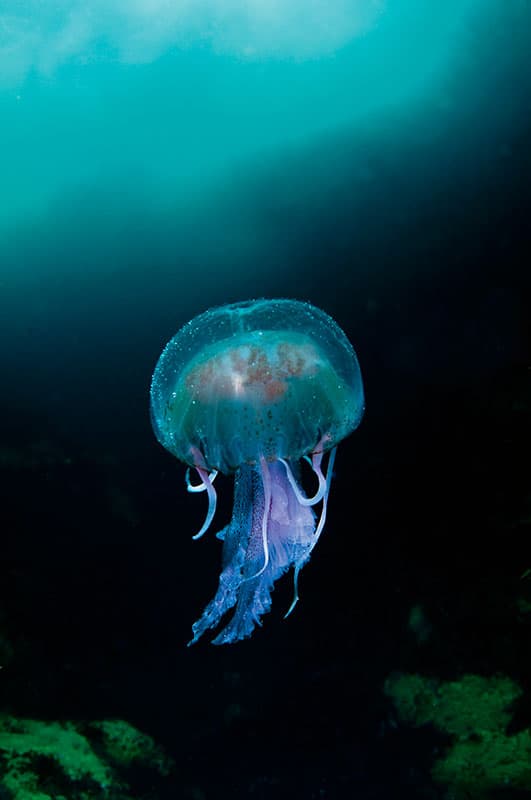Photo Insight with Richard Shucksmith – Jellyfish
Photo Insight Bringing You Essential Expert Advice Every Week
 Richard Shucksmith has studied marine biology and marine ecology. He is a keen diver and underwater photographer. Using photography he aims to tell stories about places, the environment, and the animals and plants that live there. In 2011, he won the British Wildlife Photography awards for the image seen here, called ‘Jellyfish in the Blue Sea of Sula Sgeir, Scotland’.
Richard Shucksmith has studied marine biology and marine ecology. He is a keen diver and underwater photographer. Using photography he aims to tell stories about places, the environment, and the animals and plants that live there. In 2011, he won the British Wildlife Photography awards for the image seen here, called ‘Jellyfish in the Blue Sea of Sula Sgeir, Scotland’.
Wildlife photographer and ecologist Richard Shucksmith talks about his award-winning image of a jellyfish and the methods behind his underwater photography
Officially I’m a diver and a marine ecologist, which means I often travel around the world working with different academics and universities. I sometimes work as an ‘embedded photographer’, which involves being on expeditions so I can help to document and raise awareness of the ecology the groups discover on their journey.
This image was taken during an expedition to Sula Sgeir, which is a small uninhabited island 45 miles north of Lewis in the North Atlantic. There are probably 10,000- 15,000 gannets that nest on the island.The purpose of the trip was to go out there with a small group of marine biologists, ecologists and keen amateurs to study the marine life in the area.
The diving was exceptional on this particular day. The visibility was truly amazing at 15-20 metres. It was lovely blue water and the marine life was incredible. In these offshore areas you get a lot of water movement, so you can see whole walls and arches that are covered in the most beautiful marine life.
After swimming around for a while, we found a cave on the east side that goes right through the middle of the island. It splits into several arches and you can actually swim through the entire island. We did a little exploring in the caves and as we were coming out we saw this jellyfish in mid-water. It was a scene that had to be photographed.
The first thing I did was to make sure that I was mutually buoyant with the jellyfish and then I started to move towards it slowly. The idea was to capture the jellyfish against a dark background while getting some of the lovely blue sea so the colours would really stand out in the image. There was no great drama trying to photograph the jellyfish. It was a quick and simple process that resulted in the image you see here. However, it does raise some key issues that you’ll need to know if attempting underwater photography.
In a way, many of the same principles that you apply to working with light on land also work underwater. The key thing to remember is that you often have to add your own light, as wavelengths are reduced due to the sun shining through the water. So, for example, water will slightly filter the red wavelength. You need to reintroduce a little light to restore some colour back to your subject, so that’s why this image was shot using two external flash units.

I was shooting with a Nikon D300 and a Tokina 10-17mm fisheye lens contained within an Ikelite waterproof housing. I also had two external flashes that were sync-corded to the back of the housing. Everything was shot, as it so often is, using the manual settings, as it’s important to adjust the exposure and the power of the flashes to suit the scene. You need enough light to bring out the colours, but you also need the correct exposure to bring out the blue background. It’s a bit of a balancing act.
Successful underwater photography is all about having the right kit, particularly when it comes to the lens. The distance between you and your subject is incredibly important. The less water between you, the better the image is. The further away you are, the more flash you’ll need due to the amount of water the light is attempting to penetrate.That’s why I was using a 10-17mm lens for this image.
Shooting on manual settings is about more than just having total control of the image, as the flashes and Ikelite housing mean that I have to use manual. However, people do use TTL underwater and still manage to get great results. It’s just that years of shooting have given me the instinct to know how to shoot the subject and balance the light. I suppose I don’t like leaving the camera on auto as there’s just too much in-camera guesswork, and I can’t risk it with the levels of visibility out there.
I do a lot of talks around the country about photography and ecology. Although I’m talking about the images, I often like to talk about the meaning of the pictures. Nice imagery can be used to engage people and then educate them. I really want to inspire people to become more aware of the world through my images. I work with many groups that try to use photography to educate people about the world around them. Photography is unique in that way.
This is a really beautiful example of this particular kind of jellyfish. They are rarely found inshore, but as I live in the Shetlands I see them quite a lot. It was nice to find one out here in these sorts of waters, and that leads me on to my final thought.
What I hope I can show in this image is that, while the wildlife found in other countries is fascinating, there’s so much beauty here in the UK. I won the 2011 British Wildlife Photography awards with this image, and the best thing about it was seeing the surprise that an image like this could be taken in this country. A person from the competition actually phoned me and asked several times if I had definitely taken this photograph in the UK. It intrigued me that people were finding it hard to believe.
This year we went back to Sula Sgeir and it was just incredible. There were jellyfish everywhere and it was just as spectacular as I remembered it. There’s so much to explore here in the UK, and I really want people to get out there to see it for themselves.
Richard Shucksmith was talking to Oliver Atwell
To see more of Richard’s work, visit www.ecologicalphotography.co.uk







